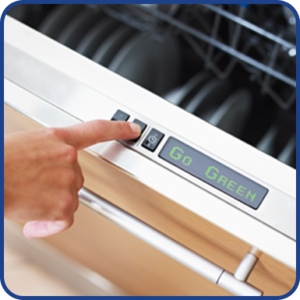Everyone believes their own way of loading a dishwasher is best, but is there a right and wrong way to stacking pots and pans? This simple task causes all sorts of family disagreements and can lead to secret re-stacking sessions after everyone has gone to bed.
Check for Dishwasher-Safe Items
Firstly, you need to make sure your items are dishwasher safe. Although you can clean most dinnerware in the dishwasher, some items should only be washed by hand – otherwise, you risk damaging them, and even your machine. Delicate items include, crystal, China, copper, cast iron, and wooden utensils.
If you’re unsure about whether something is dishwasher-safe, check your machines’ manual or look for a symbol on the item.
Load the Bottom of Your Dishwasher First
It’s important that water can circulate properly, or some items may not get a thorough clean. We recommend starting with the bottom rack:
- Plates & dishes: Load into the slots facing inwards, with the dirty side facing the water
- Pots, pans, & casserole dishes: Face downwards and avoid overcrowding or stacking
- Roasting tins & baking trays: Place along the sides and back of the rack.
Next, Load Your Dishwashers’ Cutlery Basket
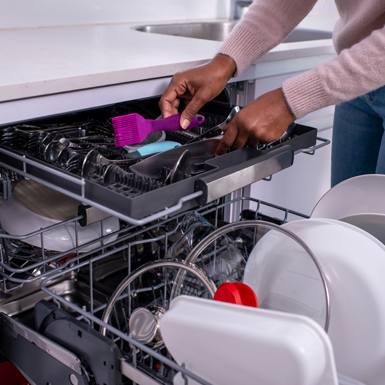
Most dishwashers have a separate cutlery basket in the bottom rack, but some larger models will have a dedicated cutlery drawer.
If your model has a cutlery basket, here are a few pointers to bear in mind:
- Make sure the forks and spoons don’t nest together – place some with handles facing up and others facing down
- Face knife blades downwards so that sharp edges are out of harm’s way
- Lay down utensils with long, thin handles on the top rack
- Keep stainless steel and silverware separate, to prevent the silver from tarnishing.
Or, if your dishwasher has a cutlery drawer:
- Lay down all utensils and make sure there’s enough space between them
- Face spoons downwards so that water doesn’t form a pool.
Load the Top of Your Dishwasher Last
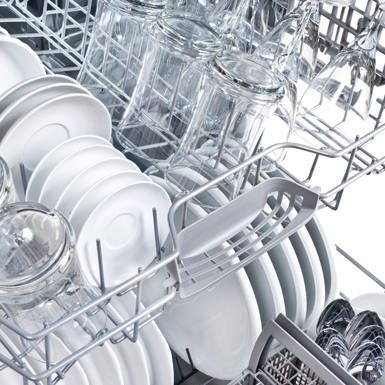
As a rule, any cups or glasses should go into the dishwasher’s top drawer. We also recommend placing small bowls on the top shelf for better cleaning. Here’s how to place these items:
- Cups & bowls: Angle these on a tilt so that the water can drain properly
- Glasses: Place along the drawer’s side for a gentler wash from water jets
- All drinkware: Avoid placing on the prongs, as this can lead to water spots. Ensure that wine glasses aren’t touching to prevent them from shattering.
All dishwasher-safe plastic items should also go on the top shelf. The machine’s heating element is normally at the bottom, so the plastic is less likely to melt at the top.
Head over to our ‘How to Clean Your Dishwasher’ blog for hints and tips on how to get the best possible clean from your appliance.
Space Enhancing Technology
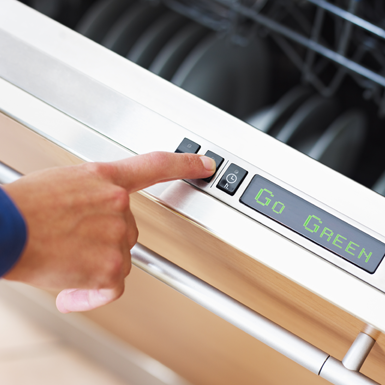
Modern dishwashers now feature space enhancing technology so you can clean all your crockery effectively, efficiently and at the same time. This means you can cut down on the amount the appliance is running - saving you time, energy, and money.
RackMatic from Bosch lets you adjust the height of the top basket in two or three stages depending on the model, making room for larger items. Whether you need to load tall glasses on the top shelf, or large pots and pans in the bottom basket, you can adjust the layout for ultimate flexibility.
Folding Plate Supports from Beko allow you to clean larger dishes, bowls, or saucepans at once. By folding the plate supports down, you have additional space to accommodate whatever comes your way – especially after the big Christmas dinner.
Helping You Save Energy & Water
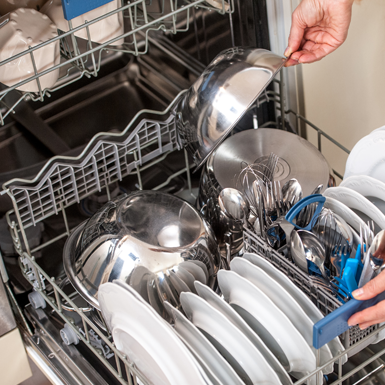
It may not seem like it, but the way you load your dishwasher makes a big difference to its efficiency. For example, should the spray arms become obstructed, they may not work as efficiently, and your crockery won’t be as sparkling as you would expect.
Being one of the main appliances in your home, they can take up a large proportion of your electricity bill. The Energy Saving Trust estimates the average annual running cost to be between £37 and £48 (around £23 - £37 for slimline models).
No matter your models’ energy rating or age, there are ways to run your dishwasher more effectively. For example:
- Don’t rinse your dishes
- Use the Eco setting if your machine has one
- Don’t run your dishwasher until its full.
Dishwashers don’t just have an impact on electricity bills, they can influence your water bill too. The Energy Saving Trust conducted an At Home With Water report, and the findings showed that hand washing dishes makes up 4% of average use, while a dishwasher only accounts for 1% of our water bills. Of course, how different households hand wash and use a dishwasher will vary, influencing the amount of water you use.
Many machines have water saving technology including Half Load and Load Sensor function, search the range online here
